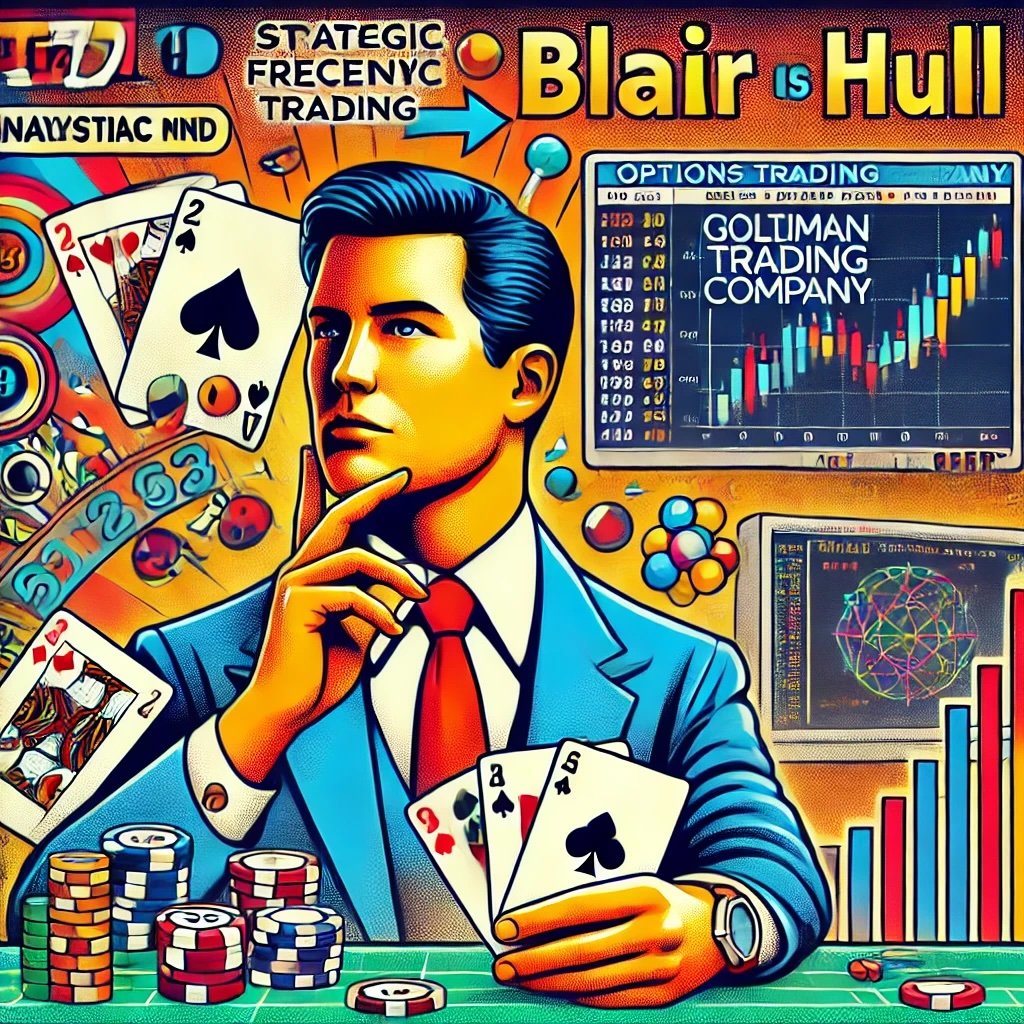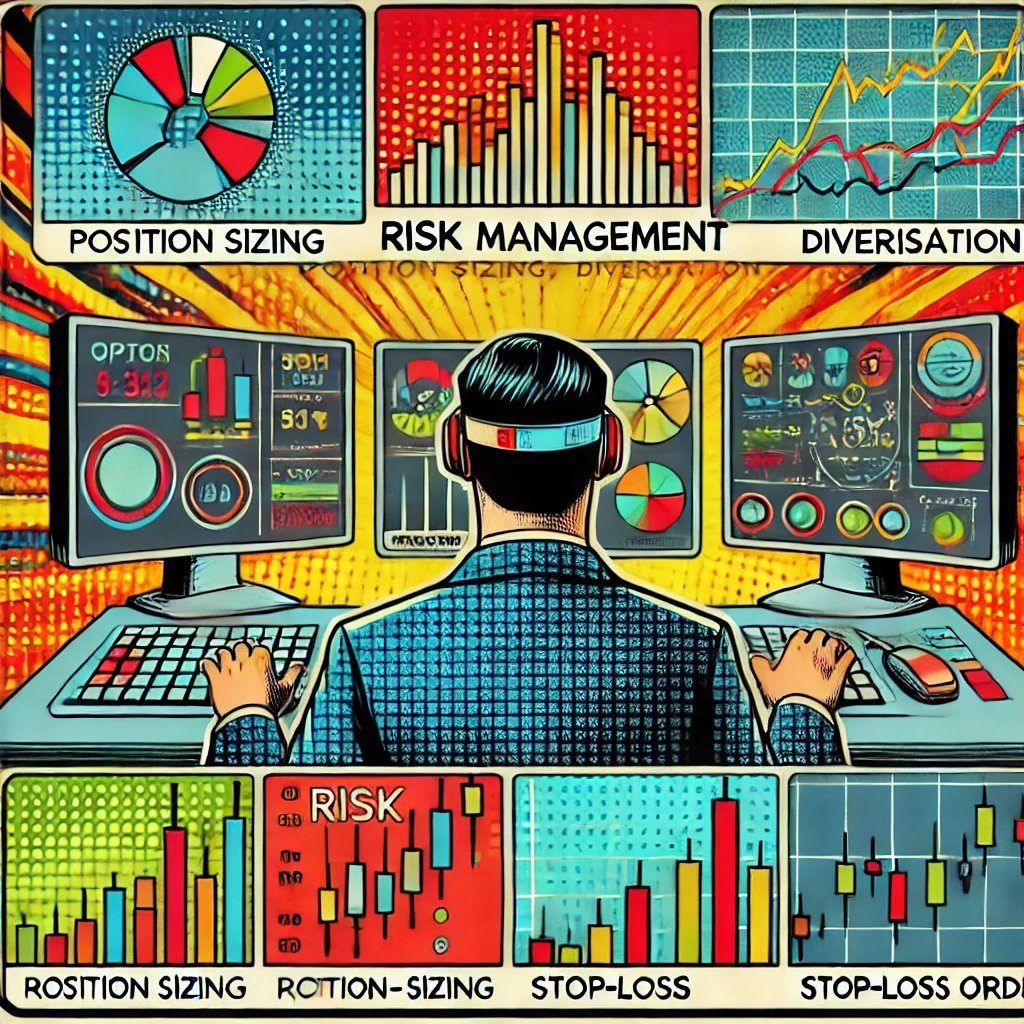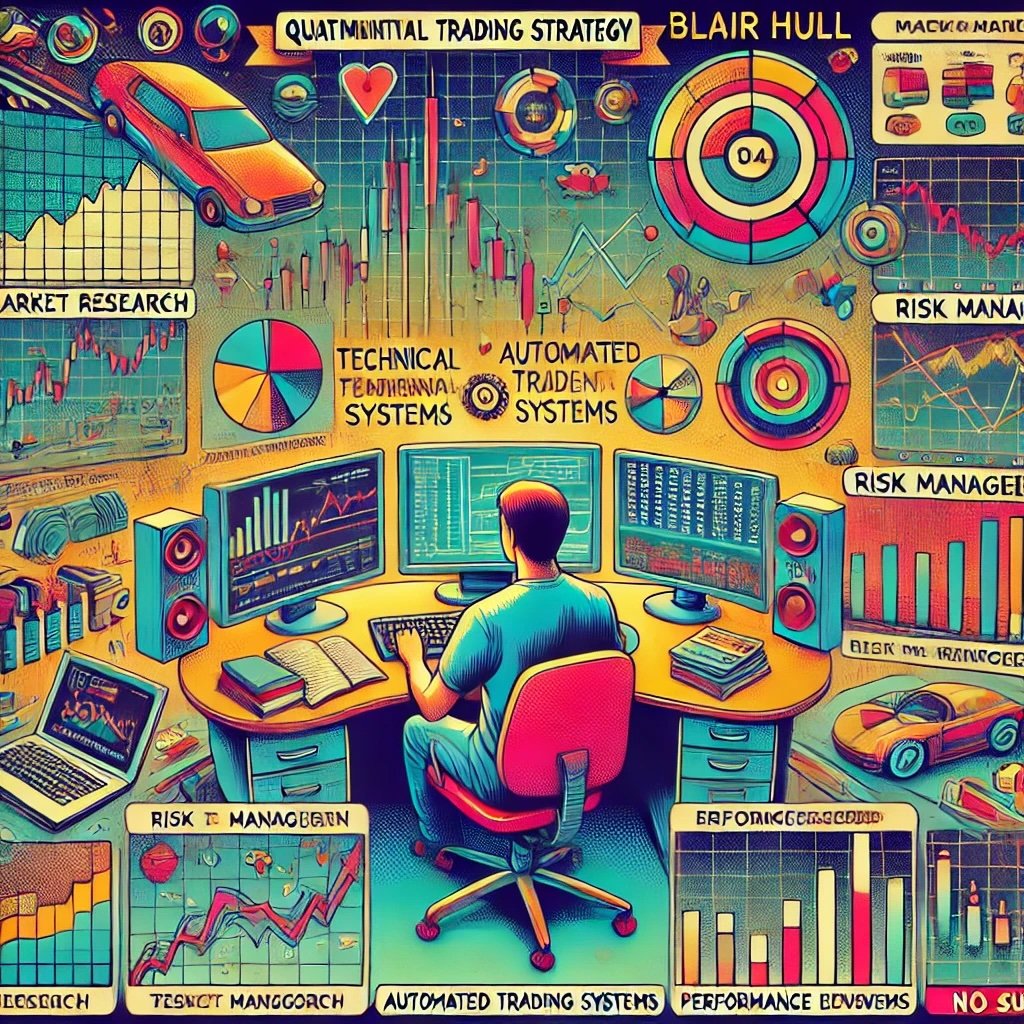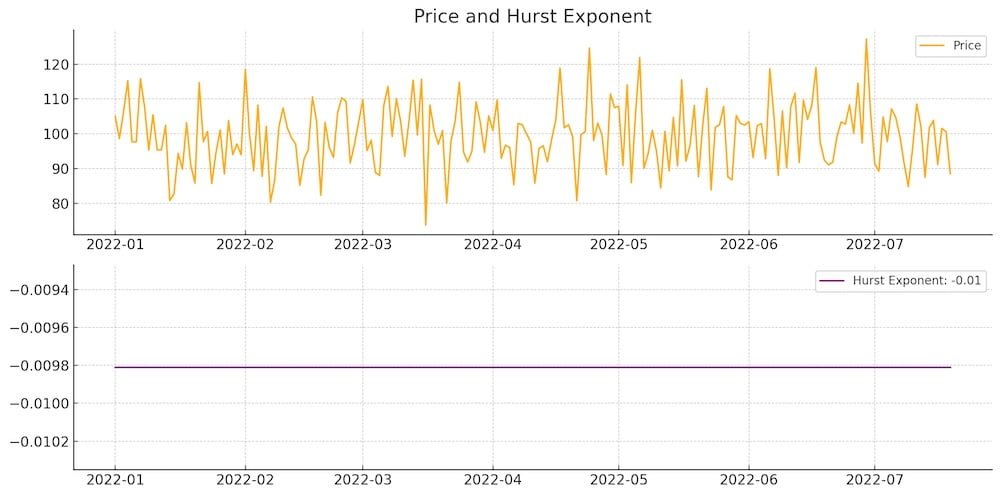Investing like a seasoned options trader requires more than just understanding the markets—it demands mastery of quantitative analysis, disciplined risk management, and the ability to leverage technology for strategic advantage. Blair Hull, a legendary figure in options trading and quantitative investing, embodies these qualities through his innovative strategies and entrepreneurial spirit. In this comprehensive guide, we’ll delve into Blair Hull’s journey, explore his core trading principles, and uncover the strategies that have cemented his status as a renowned options trader and author.
source: Chat With Traders on YouTube
Blair Hull: A Titan in Options Trading and Quantitative Investing
Blair Hull has left an indelible mark on the world of options trading and quantitative investing. As the founder of Hull Trading Company, Hull pioneered the use of quantitative models and advanced technology in trading, setting new standards for the industry. His impact extends beyond his trading success; Hull is also a respected author, sharing his insights and strategies with aspiring traders worldwide.

Understanding His Trading Philosophy and Contributions as an Author
Hull’s trading philosophy is deeply rooted in data-driven decision-making, robust risk management, and the relentless pursuit of market efficiency. His contributions as an author, particularly through his book “Option Volatility and Pricing,” have provided traders with invaluable tools and frameworks to navigate the complexities of options trading. Hull’s blend of technical expertise and practical application makes his teachings both accessible and highly effective.
We’ll explore Blair Hull’s trading strategies and his approach to options and quantitative trading. Whether you’re an experienced trader looking to refine your approach or a novice seeking to understand the fundamentals of successful trading, Hull’s methodologies offer valuable insights. We’ll break down his strategies, examine his risk management techniques, and provide practical steps to help you emulate his success in the dynamic world of options trading.

Who is Blair Hull?
Background and Early Life of Blair Hull
Blair Hull’s journey into the financial markets began with a unique combination of interests and experiences. Born with a keen analytical mind, Hull was drawn to both the mathematical precision of quantitative analysis and the strategic depth of trading. His early life was marked by a fascination with numbers and patterns, laying the groundwork for his future endeavors in the world of finance.
His Journey from a Blackjack Player to a Pioneering Options Trader
Before making waves in the financial markets, Blair Hull honed his strategic thinking and risk management skills as a blackjack player. This experience taught him the importance of probability, discipline, and the ability to stay calm under pressure—qualities that would prove invaluable in his trading career. Transitioning from the casino to Wall Street, Hull applied these principles to options trading, quickly establishing himself as a formidable trader.
Key Achievements, Including the Founding and Success of Hull Trading Company
Blair Hull’s most significant achievement is undoubtedly the founding of Hull Trading Company in 1985. Under his leadership, Hull Trading became a powerhouse in the options trading landscape, renowned for its innovative use of quantitative models and high-frequency trading techniques. Some of his key achievements include:
- Revolutionizing Quantitative Trading: Hull Trading was one of the first firms to leverage sophisticated algorithms and statistical models to execute trades at unprecedented speeds, setting new benchmarks for the industry.
- Successful Acquisition by Goldman Sachs: In 1999, Hull Trading was acquired by Goldman Sachs for an estimated $541 million, a testament to the company’s impressive performance and strategic value.
- Authorship and Educational Contributions: Hull authored several influential books and research papers on options trading and quantitative analysis, providing traders with essential knowledge and strategies to enhance their trading performance.
- Industry Recognition: Hull has been recognized as a leading figure in options trading, receiving numerous accolades for his contributions to the field and his role in shaping modern trading practices.

Core Principles of Blair Hull’s Trading Strategy
Blair Hull’s trading strategy is built upon a solid foundation of core principles that guide his decision-making process. These principles ensure that his trading remains disciplined, data-driven, and adaptable to changing market conditions.
Quantitative Analysis: Emphasis on Data-Driven Decision-Making and the Use of Algorithms in Trading
Understanding Quantitative Analysis: Quantitative analysis involves using mathematical models and statistical techniques to evaluate trading opportunities. Hull’s approach relies heavily on data-driven decision-making, where empirical evidence and historical data inform his trading strategies.
Key Components of Hull’s Quantitative Analysis:
- Algorithmic Trading: Hull pioneered the use of algorithms to execute trades automatically based on predefined criteria. This approach reduces human error and capitalizes on market inefficiencies at high speeds.
- Statistical Models: Employs sophisticated statistical models to predict price movements and identify profitable trading opportunities. These models analyze vast amounts of data to uncover patterns and correlations that are not apparent through traditional analysis.
- Backtesting: Rigorously tests trading strategies against historical data to assess their effectiveness and refine them before deploying in live markets.
Example: Using a statistical model, Hull identifies a consistent correlation between certain economic indicators and the performance of specific options. By incorporating this data into his algorithm, he can execute trades that exploit these predictable patterns, enhancing his profitability while minimizing risk.
Tip: Integrate robust quantitative analysis into your trading strategy. Utilize statistical models and algorithmic tools to identify and capitalize on market inefficiencies with precision and consistency.
Risk Management: Importance of Controlling Risk Through Position Sizing, Diversification, and Statistical Models
The Pillars of Risk Management: Risk management is a cornerstone of Hull’s trading philosophy. It ensures that potential losses are minimized, preserving capital for future trading opportunities.
Key Risk Management Techniques:
- Position Sizing: Determines the appropriate size of each trade based on the overall portfolio size and risk tolerance, preventing any single trade from having an outsized impact.
- Diversification: Spreads investments across various sectors and asset classes to mitigate the risk associated with any single investment.
- Statistical Models: Uses statistical models to assess and manage risk, ensuring that the potential downside is controlled while maximizing upside potential.
Example: Hull enters a long position in an option with a calculated position size that aligns with his overall portfolio risk parameters. By diversifying his trades across different options and underlying assets, he minimizes the impact of any single trade’s performance on his overall portfolio.
Tip: Always define your risk parameters before entering a trade. Knowing your maximum acceptable loss helps maintain discipline and prevents emotional decision-making during market turbulence.
Market Efficiency: Hull’s Belief in Exploiting Market Inefficiencies Through Technology and Quantitative Methods
Understanding Market Efficiency: Hull operates under the belief that markets are not always perfectly efficient. By leveraging technology and quantitative methods, traders can identify and exploit inefficiencies to achieve superior returns.
Key Aspects of Hull’s Market Efficiency Approach:
- Identifying Inefficiencies: Uses quantitative models to detect pricing anomalies and market inefficiencies that can be exploited for profit.
- Technological Advantage: Implements advanced trading technologies to execute trades faster and more accurately than competitors, capitalizing on fleeting opportunities.
- Continuous Monitoring: Continuously monitors market conditions and adjusts strategies to stay ahead of emerging inefficiencies.
Example: Hull’s algorithms detect a pricing discrepancy between related options contracts. By swiftly executing trades to take advantage of this mispricing, Hull secures a profit before the market corrects the inefficiency.
Tip: Stay abreast of technological advancements and incorporate them into your trading strategy to maintain a competitive edge in identifying and exploiting market inefficiencies.
Continuous Improvement: Hull’s Commitment to Refining and Improving Trading Systems and Strategies
The Importance of Continuous Improvement: Hull believes that the markets are constantly evolving, and so should trading strategies. Continuous improvement ensures that trading systems remain effective and adapt to changing market dynamics.
Key Practices for Continuous Improvement:
- Ongoing Research: Invests time and resources into researching new trading models and strategies to enhance performance.
- Performance Analysis: Regularly analyzes trading performance to identify strengths and areas for improvement, refining strategies accordingly.
- Adapting to Change: Adjusts trading systems in response to market changes, ensuring that strategies remain relevant and effective.
Example: After a series of trades, Hull conducts a performance review and identifies that his current model underperforms during certain market conditions. He then develops and integrates a new model tailored to these conditions, improving overall trading performance.
Tip: Embrace a mindset of continuous learning and adaptability. Regularly evaluate and refine your trading strategies to ensure they remain effective in evolving market environments.

The Development of Hull Trading Company
Overview of Hull Trading Company’s Founding and Growth
Blair Hull founded Hull Trading Company in 1985 with a vision to revolutionize the options trading landscape through quantitative analysis and technological innovation. Starting with a small team of like-minded traders and quantitative analysts, Hull Trading quickly established itself as a leader in the field by leveraging advanced mathematical models and automated trading systems.
Key Milestones in Hull Trading’s Growth:
- Early Adoption of Technology: Hull Trading was among the first firms to adopt electronic trading platforms, enhancing trade execution speed and accuracy.
- Expansion of Quantitative Models: Continuously developed and refined quantitative models to improve trading performance and identify new trading opportunities.
- Scaling Operations: Expanded its operations globally, establishing offices in major financial hubs to tap into diverse markets and enhance liquidity.
- High-Frequency Trading: Pioneered high-frequency trading strategies, executing thousands of trades per second to capitalize on minute market inefficiencies.
How Hull Leveraged Technology and Quantitative Models to Gain a Competitive Edge
Technological Innovations: Hull Trading invested heavily in cutting-edge technology, recognizing its pivotal role in gaining a competitive advantage. By developing proprietary trading software and algorithms, the firm could execute trades faster and more efficiently than competitors.
Quantitative Models: Hull’s quantitative models were designed to analyze vast amounts of market data, identifying patterns and predicting price movements with high accuracy. These models incorporated various factors, including volatility, liquidity, and historical price trends, to inform trading decisions.
Integration of Technology and Quantitative Analysis: The seamless integration of technology and quantitative analysis allowed Hull Trading to implement complex trading strategies with precision. Automated systems executed trades based on model-generated signals, ensuring consistency and eliminating human error.
Example: Hull Trading’s proprietary algorithm detects a correlation between increased trading volume and subsequent price movements in a particular option. The system automatically executes a series of trades to capitalize on this pattern, securing profits before the correlation fades.
Tip: Invest in technology and develop robust quantitative models to enhance your trading capabilities. The combination of advanced technology and data-driven analysis provides a significant edge in identifying and exploiting market opportunities.
The Company’s Success and Eventual Acquisition by Goldman Sachs
Hull Trading’s innovative approach and consistent performance attracted significant attention in the financial industry. By the late 1990s, Hull Trading had established itself as a dominant player in the options trading space, renowned for its high-frequency trading capabilities and superior risk management practices.
Key Factors Leading to Success:
- Innovative Trading Strategies: Continuously developed and refined trading strategies that leveraged quantitative analysis and technological advancements.
- Strong Performance: Delivered consistent returns, outperforming major market indices and earning the trust of investors and stakeholders.
- Reputation for Excellence: Built a reputation for excellence in trading, attracting top talent and fostering a culture of innovation and continuous improvement.
Acquisition by Goldman Sachs: In 1999, Goldman Sachs acquired Hull Trading Company for an estimated $541 million. This acquisition was a strategic move by Goldman Sachs to bolster its own trading capabilities and integrate Hull Trading’s advanced quantitative models and high-frequency trading systems into its operations.
Impact of the Acquisition:
- Enhanced Trading Capabilities: Goldman Sachs gained access to Hull Trading’s proprietary technology and quantitative expertise, enhancing its own trading operations.
- Integration of Best Practices: Incorporated Hull Trading’s risk management and trading strategies into its broader business model, improving overall performance.
- Legacy of Innovation: Hull Trading’s legacy of innovation continued under Goldman Sachs, influencing the development of advanced trading technologies and quantitative strategies within the firm.
Tip: Building a strong reputation through consistent performance and innovation can attract strategic partnerships and acquisition opportunities, further expanding your trading operations and influence in the industry.

Famous Trades and Innovations
Analysis of Some of Hull’s Most Notable Trades and Market Innovations
Blair Hull’s trading career is adorned with remarkable trades and groundbreaking market innovations that have solidified his reputation as a top options trader. His ability to anticipate market movements and implement innovative strategies has led to significant successes and advancements in the trading industry.
Notable Trades:
- Volatility Arbitrage: Hull capitalized on discrepancies in implied and realized volatility. By identifying options that were mispriced relative to their actual volatility, he executed trades that profited from the convergence of these volatility measures.
- Statistical Arbitrage: Utilizing quantitative models, Hull engaged in statistical arbitrage, identifying pricing inefficiencies between related securities. These trades involved simultaneous buying and selling of correlated options to lock in risk-free profits.
- Earnings Announcements: Hull developed strategies to trade options around earnings announcements. By analyzing historical data and volatility patterns, he predicted price movements with high accuracy, capitalizing on post-announcement volatility.
- Interest Rate Options: Hull implemented options trading strategies based on interest rate movements. By forecasting changes in interest rates, he executed trades that benefited from subsequent price adjustments in interest rate-linked options.
How His Quantitative Approach and Use of Technology Led to Significant Successes
Hull’s quantitative approach, combined with his strategic use of technology, has been instrumental in his trading successes. By leveraging data-driven models and automated trading systems, Hull could execute complex strategies with precision and speed, outpacing competitors and maximizing profits.
Key Factors in His Success:
- Data-Driven Decision Making: Relied on empirical data and statistical models to inform trading decisions, reducing reliance on intuition and emotional biases.
- Advanced Technology: Utilized cutting-edge trading platforms and algorithms to execute trades faster and more accurately than manual trading methods.
- Risk Control: Implemented robust risk management techniques to protect capital and sustain long-term trading performance.
- Continuous Innovation: Continuously refined trading models and strategies to adapt to changing market conditions and exploit new opportunities.
Example: During a period of high market volatility, Hull’s quantitative models identified a mispricing in a specific option. Leveraging his automated trading system, he executed a large volume of trades to exploit this inefficiency, securing substantial profits before the market corrected the mispricing.
Tip: Embrace a quantitative and technology-driven approach to trading. Utilizing data and advanced trading systems can enhance decision-making accuracy and execution speed, leading to superior trading performance.
Lessons Learned from These Trades and Their Relevance Today
1. Importance of Quantitative Models: Hull’s reliance on quantitative models underscores their significance in identifying and capitalizing on market inefficiencies. Robust models provide a systematic approach to trading, enhancing consistency and profitability.
2. Leveraging Technology: The integration of advanced technology in trading operations is crucial for executing strategies efficiently and accurately. Automation reduces the likelihood of human error and enables traders to capitalize on fleeting market opportunities.
3. Robust Risk Management: Effective risk management is essential for preserving capital and sustaining long-term trading success. Hull’s disciplined approach to risk ensures that losses are minimized, allowing for continued trading and growth.
4. Continuous Innovation and Adaptation: Markets are dynamic, and strategies must evolve to remain effective. Hull’s commitment to innovation and continuous improvement ensures that his trading strategies stay relevant and profitable in changing market conditions.
Tip: Learn from successful traders by integrating quantitative analysis, leveraging technology, and maintaining robust risk management practices into your own trading strategy.

Risk Management Techniques
Detailed Look at Hull’s Approach to Managing Risk in Options Trading
Risk management is a cornerstone of Blair Hull’s trading strategy. By implementing comprehensive risk management techniques, Hull ensures that his capital is protected and his portfolio remains resilient against market volatility.
Key Components of Hull’s Risk Management:
- Position Sizing: Determines the appropriate size of each trade based on the overall portfolio size and risk tolerance, preventing any single trade from having an outsized impact.
- Diversification: Spreads investments across various sectors and asset classes to mitigate the risk associated with any single investment.
- Statistical Models: Uses statistical models to assess and manage risk, ensuring that the potential downside is controlled while maximizing upside potential.
Use of Stop-Loss Orders, Position Sizing, and Trading Discipline
Stop-Loss Orders:
Hull uses stop-loss orders to protect his trades from significant losses. By setting a stop-loss level, he ensures that losses are limited if the market moves against his position.
Example: Hull enters a long position in an option at a premium of $5. He sets a stop-loss order at $4.50, ensuring that if the option’s price drops to $4.50, the position is automatically sold, limiting his loss to $0.50 per option.
Position Sizing:
Determining the right position size is crucial for managing risk. Hull calculates position sizes based on the volatility of the option and his overall portfolio size, ensuring that no single trade jeopardizes his capital.
Example: For a highly volatile option, Hull might allocate a smaller portion of his portfolio to each trade compared to a less volatile option. This approach helps in managing risk while allowing for potential gains.
Trading Discipline:
Maintaining discipline is essential for consistent trading success. Hull strictly follows his trading plan, avoiding impulsive decisions based on emotions or short-term market fluctuations.
Example: During periods of high market volatility, Hull remains calm and adheres to his stop-loss levels and position sizing rules, preventing emotional trading that could lead to significant losses.
Tip: Incorporate stop-loss orders and carefully calculate position sizes to manage risk effectively. Maintaining discipline ensures that your trading decisions remain objective and aligned with your long-term strategy.
Balancing Risk and Reward in a Volatile Market Environment
Balancing risk and reward is vital for sustaining long-term trading success, especially in volatile markets. Hull employs several strategies to achieve this balance:
- Optimal Asset Allocation: Distributes investments across various options and underlying assets to spread risk and enhance potential returns.
- Risk-Reward Analysis: Assesses the potential returns of each trade relative to its risk, aiming for trades with favorable risk-reward ratios.
- Diversified Portfolio: Maintains a diversified portfolio to reduce the impact of any single trade’s performance on the overall portfolio.
Example: In a highly volatile market, Hull might reduce position sizes and tighten stop-loss levels to limit potential losses while maintaining exposure to high-potential trades with favorable risk-reward profiles.
Tip: Regularly review and adjust your risk-reward ratios to ensure that they align with your overall trading goals and market conditions.

The Role of Psychology in Trading
Hull’s Views on the Psychological Challenges of Trading
Blair Hull recognizes that trading is as much a psychological endeavor as it is a technical one. The emotional highs and lows, the pressure of making quick decisions, and the fear of losses can significantly impact trading performance. Hull emphasizes the importance of mastering the psychological aspects of trading to achieve consistent success.
Key Psychological Challenges:
- Emotional Trading: Making decisions based on emotions like fear, greed, or excitement rather than rational analysis.
- Overconfidence: Believing too much in one’s own trading abilities, leading to excessive risk-taking.
- Loss Aversion: The tendency to prefer avoiding losses over acquiring gains, which can result in holding onto losing positions too long.
- Stress and Pressure: Managing the stress that comes with the high-stakes environment of trading.
Techniques for Maintaining Discipline and Emotional Control
To navigate the psychological challenges of trading, Hull employs several techniques aimed at fostering discipline and emotional resilience:
- Structured Trading Plan: Having a detailed trading plan that outlines entry and exit criteria, risk management rules, and performance benchmarks helps maintain focus and prevent impulsive decisions.
- Mindfulness and Stress Management: Practices like meditation, deep breathing exercises, and regular physical activity help Hull manage stress and maintain mental clarity, enabling him to stay calm and focused during trading sessions.
- Regular Performance Reviews: Conducting periodic reviews of his trading performance allows Hull to identify patterns of emotional decision-making and adjust his strategies accordingly.
- Goal Setting: Setting clear, achievable trading goals provides direction and motivation, helping Hull stay committed to his strategies even during challenging market conditions.
Example: During a volatile market day, Hull remains calm and adheres to his trading plan instead of succumbing to panic selling or impulsive buying. This disciplined approach helps him navigate turbulent markets without incurring unnecessary losses.
Tip: Develop a structured routine that includes stress management techniques and regular performance reviews to maintain emotional control and discipline in your trading.
The Importance of Mental Resilience and Adaptability in Executing Trades Effectively
Mental resilience is crucial for overcoming the inevitable setbacks and challenges in trading. Hull emphasizes the need to build mental toughness to handle losses, stay motivated, and maintain a positive outlook.
Strategies to Build Mental Resilience:
- Acceptance of Losses: Recognizing that losses are a natural part of trading and learning from them rather than dwelling on them.
- Positive Mindset: Maintaining a positive attitude and focusing on long-term goals instead of short-term setbacks.
- Continuous Learning: Viewing each trading experience as an opportunity to learn and improve, thereby fostering a growth mindset.
- Support Systems: Engaging with mentors, peers, and support networks to gain perspective and encouragement during tough times.
Example: After experiencing a series of losing trades, Hull reviews his strategies to identify areas for improvement. Instead of getting discouraged, he uses the experience as a learning opportunity to refine his approach and enhance his future trading performance.
Tip: Cultivate a growth mindset by viewing challenges as opportunities for learning and improvement. This approach helps you stay resilient and adaptable in the face of trading setbacks.

Building a Quantitative Trading Strategy Like Blair Hull
Step-by-Step Guide to Developing a Quantitative Trading Strategy Inspired by Hull
Emulating Blair Hull’s trading strategies involves adopting his disciplined approach to quantitative analysis, risk management, and psychological resilience. Here’s a practical guide to developing a quantitative trading strategy inspired by Hull.
1. Research and Analysis
- Comprehensive Market Research: Begin by conducting thorough research on the options and commodities you intend to trade. Understand the factors that influence price movements, such as supply and demand dynamics, economic indicators, and geopolitical events.
- Technical and Fundamental Analysis: Combine technical analysis (chart patterns, moving averages, RSI) with fundamental analysis (earnings reports, economic indicators) to identify high-potential trading opportunities.
- Use of Proprietary Indicators: Incorporate tools like Hull’s proprietary quantitative models and algorithms to gain deeper insights into market sentiment and momentum.
2. Identifying and Analyzing Potential Trades
- Option Selection Criteria: Establish clear criteria for selecting options contracts, such as liquidity, volatility, and the underlying asset’s performance.
- Trend Identification: Use moving averages and trendlines to identify prevailing market trends, ensuring alignment with your trading strategy.
- Volatility Assessment: Analyze implied and realized volatility to determine the potential profitability of options trades. Hull often seeks to exploit discrepancies between implied and realized volatility.
3. Implementing Risk Management Strategies
- Stop-Loss Orders: Set stop-loss orders for each trade to limit potential losses and protect your capital.
- Position Sizing: Determine the appropriate size of each position based on the risk profile of the option and your overall portfolio strategy.
- Diversification: Spread your investments across different options and underlying assets to mitigate the impact of sector-specific downturns.
4. Executing the Trading Plan
- Strategic Entry and Exit Points: Identify optimal entry points using technical indicators and quantitative signals, and set predefined exit points to lock in profits or limit losses.
- Automated Trading Systems: Utilize automated trading systems to execute trades based on your quantitative models, ensuring consistency and speed.
- Continuous Monitoring: Regularly monitor your trades and the broader market conditions to ensure that your positions remain aligned with your trading objectives.
5. Continuous Evaluation and Adaptation
- Performance Review: Conduct regular reviews of your trading performance to assess the effectiveness of your strategies and identify areas for improvement.
- Adapt to Market Conditions: Be prepared to adjust your strategies based on changing market dynamics, economic indicators, and emerging trends.
- Innovate and Refine: Incorporate new trading techniques and tools to enhance your strategy and stay ahead of market developments.
Tips for Refining and Adapting the Strategy Over Time
- Stay Flexible: Be willing to pivot your strategy as new information and trends emerge. Flexibility allows you to capitalize on unexpected opportunities and mitigate emerging risks.
- Learn Continuously: Invest in your education to stay ahead of market developments. Attend seminars, read extensively, and engage with financial experts to enhance your knowledge.
- Seek Expertise: Collaborate with analysts and industry experts to gain diverse perspectives. Leveraging specialized knowledge can provide deeper insights into complex markets.
- Implement Feedback Loops: Use feedback from performance reviews and market analyses to iteratively improve your strategy, ensuring it remains robust and effective.
Tip: Regularly review and adjust your trading strategy to incorporate new insights and respond to evolving market conditions, ensuring sustained performance and growth.

Challenges of Quantitative and Options Trading
Potential Pitfalls and Difficulties in Adopting Quantitative and Options Trading Strategies
Adopting quantitative and options trading strategies presents several challenges that require strategic planning and disciplined execution to overcome. Understanding these potential pitfalls is essential for developing a resilient and effective trading strategy.
Common Challenges:
- Market Volatility: Options trading is highly sensitive to market volatility, which can lead to significant price swings and potential losses.
- Model Risk: Relying on quantitative models introduces the risk that the models may be flawed or based on incorrect assumptions, leading to inaccurate predictions and trading decisions.
- Data Overload: Managing and analyzing vast amounts of data can be overwhelming, making it challenging to focus on the most relevant information and indicators.
- Technological Dependence: Quantitative trading relies heavily on advanced technology and automated systems, which can fail or malfunction, leading to potential trading disruptions.
- Regulatory Compliance: Navigating the complex regulatory landscape of options trading requires meticulous attention to detail and adherence to various rules and regulations.
How to Overcome Common Challenges
1. Managing Market Volatility
- Implement Robust Risk Management: Use stop-loss orders and position sizing to limit exposure during volatile periods.
- Stay Informed: Keep abreast of economic indicators and geopolitical events that could impact market volatility, allowing you to anticipate and prepare for potential swings.
- Maintain a Diversified Portfolio: Spread your investments across different options and underlying assets to reduce exposure to any single market segment.
2. Mitigating Model Risk
- Robust Model Testing: Rigorously backtest your quantitative models against historical data to assess their accuracy and reliability.
- Continuous Monitoring: Regularly monitor model performance and update models as needed to reflect changing market conditions.
- Incorporate Multiple Models: Use a combination of different models to validate trading signals and reduce reliance on any single model.
3. Handling Data Overload
- Focus on Relevant Data: Prioritize key indicators and information that directly impact your trading strategy, filtering out irrelevant noise.
- Use Analytical Tools: Leverage advanced analytical tools and software to streamline data analysis and focus on actionable insights.
- Stay Organized: Develop a structured approach to data management, such as setting specific times for data review and analysis.
4. Ensuring Technological Reliability
- Invest in Quality Infrastructure: Use reliable and high-performance trading platforms and hardware to minimize the risk of technological failures.
- Regular Maintenance: Conduct regular maintenance and updates of your trading systems to ensure they operate smoothly and efficiently.
- Have Backup Systems: Implement backup systems and contingency plans to ensure continuity in case of technological disruptions.
5. Navigating Regulatory Compliance
- Stay Updated: Keep informed about regulatory changes and updates to ensure timely compliance with all relevant laws and regulations.
- Consult Experts: Engage with legal and compliance experts to navigate the complex regulatory requirements of options trading.
- Implement Compliance Frameworks: Develop comprehensive compliance frameworks that include regular audits, reporting, and adherence to best practices.
Tip: Develop a comprehensive understanding of the specific challenges associated with quantitative and options trading and implement targeted strategies to mitigate these risks effectively.
The Importance of Continuous Learning and Adaptation in Trading
In the dynamic environment of quantitative and options trading, continuous learning and adaptation are crucial for sustained success. Markets evolve rapidly, influenced by technological advancements, regulatory changes, and shifting economic conditions. Traders must remain vigilant and proactive to stay ahead of these changes.
Key Practices for Continuous Learning and Adaptation:
- Ongoing Education: Engage in continuous education through courses, seminars, and financial publications to stay updated on market trends and trading techniques.
- Leverage Technology: Utilize advanced trading platforms and analytical tools to monitor market conditions in real-time and adapt your strategies accordingly.
- Networking: Connect with other traders, analysts, and financial experts to exchange insights and stay abreast of the latest market developments.
- Flexibility in Strategy: Be prepared to adjust your trading strategies based on new information, market conditions, and evolving economic indicators.
Example: When regulatory changes impact options trading rules, Hull swiftly adjusts his trading strategies to comply with the new regulations while still capitalizing on profitable opportunities within the updated framework.
Tip: Cultivate a mindset of continuous improvement and adaptability, ensuring that your trading strategies remain relevant and effective in evolving market environments.

How to Start Trading Like Blair Hull
Practical Steps for Implementing Hull’s Strategies in Your Own Trading
Emulating Blair Hull’s trading strategies involves adopting his disciplined approach to quantitative analysis, risk management, and psychological resilience. Here’s a practical guide to implementing Hull’s strategies in your own trading.
1. Develop a Comprehensive Research Process
- In-Depth Analysis: Conduct thorough research on the options and commodities you intend to trade. Understand the factors that influence price movements, such as supply and demand dynamics, economic indicators, and geopolitical events.
- Technical and Fundamental Analysis: Combine technical analysis (chart patterns, moving averages, RSI) with fundamental analysis (earnings reports, economic indicators) to identify high-potential trading opportunities.
- Use of Proprietary Indicators: Incorporate tools like Hull’s proprietary quantitative models and algorithms to gain deeper insights into market sentiment and momentum.
2. Implement Robust Risk Management Practices
- Capital Preservation: Prioritize the protection of your invested capital by avoiding overly risky trades and focusing on high-probability setups.
- Position Sizing: Determine the appropriate size of each position based on the risk profile of the option and your overall portfolio strategy.
- Use of Stop-Loss Orders: Implement stop-loss orders to limit potential losses and protect your capital from significant downturns.
3. Adopt a Diversified Portfolio Approach
- Asset Class Diversification: Invest across various options and underlying assets to spread risk and enhance portfolio stability.
- Sector and Geographic Diversification: Spread your investments across different sectors and regions to mitigate the impact of sector-specific downturns or regional economic challenges.
- Balanced Exposure: Ensure a balanced exposure to high-growth and defensive sectors to maintain portfolio stability.
4. Integrate Behavioral Finance Principles
- Recognize Biases: Identify and mitigate common cognitive biases that can impair investment decision-making.
- Maintain Emotional Discipline: Stick to your investment plan and avoid making impulsive decisions based on emotions.
- Focus on Long-Term Goals: Prioritize long-term growth over short-term gains to ensure sustained investment performance.
5. Maintain an Adaptive Investment Strategy
- Monitor Market Conditions: Continuously assess market conditions and adjust your investment strategy accordingly.
- Stay Flexible: Be prepared to pivot your strategy in response to new information, emerging trends, and changing market dynamics.
- Innovate and Refine: Incorporate new trading techniques and tools to enhance your strategy and stay ahead of market developments.
Resources for Learning More About Quantitative and Options Trading Techniques
- Books:
- “Option Volatility and Pricing” by Sheldon Natenberg
- “Quantitative Trading: How to Build Your Own Algorithmic Trading Business” by Ernest P. Chan
- “Market Wizards” by Jack D. Schwager
- Online Courses:
- Coursera’s Financial Engineering and Risk Management specialization
- Udemy’s Algorithmic Trading & Quantitative Analysis Using Python
- edX’s Introduction to Computational Finance and Financial Econometrics
- Professional Certifications:
- Chartered Financial Analyst (CFA)
- Chartered Market Technician (CMT)
- Seminars and Webinars:
- Attend industry conferences and webinars hosted by reputable financial institutions and trading firms.
- Participate in online trading communities and forums to exchange insights and strategies with other traders.
Tools and Platforms to Support Quantitative and Options Trading Activities
- Analytical Tools:
- Bloomberg Terminal: Comprehensive platform for financial data, news, and analytics.
- TradingView: Advanced charting platform with a wide range of technical indicators and social networking features for traders.
- MetaTrader 4/5: Popular trading platforms offering extensive technical analysis tools and automated trading capabilities.
- Trading Platforms:
- Interactive Brokers: Offers low-cost commissions, advanced trading tools, and a wide range of investment options.
- Thinkorswim by TD Ameritrade: Robust platform with advanced charting and trading capabilities.
- E*TRADE Pro: Professional-grade trading platform with extensive research tools and real-time data.
- Portfolio Management Software:
- Portfolio Visualizer: Tool for portfolio analysis, backtesting, and optimization.
- Personal Capital: Comprehensive financial planning and portfolio management platform.
- Quicken: Personal finance management tool with investment tracking features.
Tip: Invest in high-quality analytical and trading tools to enhance your investment analysis and execution capabilities, enabling you to make informed and strategic trading decisions.
Blair Hull–Style Options Trading FAQ: Quant, Volatility, Risk, Psychology, and a Practical Starter Playbook
1) Who is Blair Hull and why do traders study his approach?
Blair Hull is a legendary options trader and entrepreneur who founded Hull Trading Company, a pioneering firm in quantitative and technology-driven market-making. Traders study his approach because it blends rigorous statistics, fast execution, disciplined risk controls, and continual system improvement—principles that remain durable across regimes.
2) What are the core pillars of a “Blair Hull–style” strategy?
Four pillars: (1) data-driven models to generate signals, (2) technology/automation for consistent, fast execution, (3) strict risk controls (position sizing, diversification, pre-defined exits), and (4) continuous research and post-trade reviews to iterate and improve.
3) How does volatility actually drive options results here?
Volatility is the oxygen of options trading. A Hull-style approach measures and forecasts realized vs. implied volatility, seeks mispricings between them, and structures trades (spreads, delta-hedged positions, event plays) to harvest the edge while managing tail risk.
4) What role do the Greeks play in day-to-day decisions?
Delta manages directional exposure; gamma shows how fast delta changes; vega captures sensitivity to implied vol; theta shows time decay; rho covers rate risk. In practice, traders target a desired net exposure (e.g., long/short vega, neutral delta) and keep the book inside pre-set Greek limits.
5) What’s the Hull-style view on entries and exits?
Entries are model-driven (signals based on stats/vol/microstructure). Exits are pre-defined: profit targets, time stops (decay/vol windows), and hard risk limits. The key is executing the plan consistently, not “feeling” the market in the moment.
6) How should I size positions to control risk?
Use small, repeatable risk per idea (e.g., a fixed % of equity or volatility-scaled sizing), cap exposure by symbol/sector/Greek, and pre-define a portfolio VaR or max drawdown level that triggers de-risking. The goal is many small, independent bets—not one hero trade.
7) What kinds of trades fit this framework for individuals?
Liquid, mechanical structures: vertical spreads, calendars/diagonals around earnings or macro dates, and delta-hedged long/short volatility expressions. Favor highly traded underlyings with tight markets so your edge isn’t eaten by slippage.
8) How do I backtest and avoid overfitting?
Use out-of-sample and walk-forward tests, stress scenarios, and realistic frictions (commissions, slippage, borrow). Keep parameter counts low, prefer simple rules that survive different regimes, and track live “paper” results before allocating real capital.
9) What tools and data are most useful?
You’ll need: quality historical options chains (with IV and Greeks), robust execution (good routing, conditional orders), and analytics that recalc Greeks and P&L in real time. Automation (even basic) helps enforce rules and reduce emotional overrides.
10) How do I handle earnings and other events?
Treat events as their own regime. Model pre- and post-event implied/realized vol patterns per ticker, size smaller, set tight loss limits, and use structures (e.g., calendars/straddles/strangles or verticals) that express your view on both move size and directionality.
11) What are the most common mistakes to avoid?
Oversizing, ignoring slippage, selling naked convexity without brakes, averaging losers, and abandoning the plan after a few losses. Another big one: mistaking short-term luck for a robust edge. Let the data—not a hot streak—set your convictions.
12) How can I start today with a simple, Hull-inspired playbook?
Pick 5–10 liquid underlyings; define one or two mechanical setups (e.g., volatility spread + earnings calendar); write explicit rules for entry/exit/sizing; backtest + paper trade; then go live at small size. Review weekly: what worked, what didn’t, and what to refine next.

Summary of the Key Takeaways from Blair Hull’s Trading Approach
Blair Hull’s trading approach is a blend of disciplined quantitative analysis, robust risk management, market efficiency exploitation, and continuous improvement. By focusing on data-driven decision-making, controlling risk through position sizing and diversification, and leveraging technology to identify and capitalize on market inefficiencies, Hull has consistently delivered impressive returns in the competitive world of options trading.
Key Takeaways:
- Quantitative Analysis: Emphasizing data-driven decision-making and the use of sophisticated algorithms to identify trading opportunities.
- Risk Management: Prioritizing capital preservation through position sizing, diversification, and the use of statistical models to control downside risk.
- Market Efficiency: Believing in the ability to exploit market inefficiencies through advanced technology and quantitative methods.
- Continuous Improvement: Committing to the ongoing refinement and improvement of trading systems and strategies to adapt to changing market conditions.
- Technological Integration: Leveraging cutting-edge technology to execute trades faster and more accurately than competitors.
- Discipline and Consistency: Maintaining strict adherence to a trading plan and avoiding impulsive decisions based on emotions or short-term market fluctuations.
- Adaptability: Being flexible and willing to adjust strategies based on new information, emerging trends, and evolving market dynamics.
- Educational Contributions: Sharing knowledge through authorship and mentorship, helping other traders develop their own successful strategies.
Relevance of His Strategies in Today’s Markets
In today’s fast-paced and technologically driven financial markets, the principles of Blair Hull’s trading strategies remain highly relevant. The integration of quantitative analysis and advanced technology is more accessible than ever, allowing traders to implement data-driven strategies that can adapt to rapid market changes. Hull’s emphasis on robust risk management and continuous improvement provides a solid framework for navigating the complexities of modern options trading.
Relevance in Modern Markets:
- Technological Advancements: Leveraging advanced analytical tools and proprietary algorithms enhances the ability to make informed trading decisions and execute strategies with precision.
- Globalization: Understanding global economic trends and their impact on options and commodities helps in making strategic investment choices.
- Market Volatility: Robust risk management techniques are essential for protecting capital and sustaining long-term performance in volatile markets.
- Behavioral Insights: Incorporating behavioral finance principles helps in mitigating emotional biases and improving trading discipline.
Example: In an era where algorithmic trading and high-frequency trading dominate, Hull’s balanced approach—combining quantitative analysis with disciplined risk management—offers a resilient strategy that can withstand the rapid fluctuations of modern markets.
Explore and Experiment with These Strategies
Emulating Blair Hull’s trading strategies requires dedication, discipline, and a commitment to continuous learning. However, by adopting his core principles and integrating them into your own trading approach, you can enhance your trading performance and build a resilient and successful investment portfolio.
Actionable Steps:
- Adopt a Quantitative Mindset: Embrace data-driven decision-making and develop or utilize quantitative models to inform your trading strategies.
- Implement Robust Risk Management: Prioritize capital preservation through effective risk management techniques, including position sizing, diversification, and stop-loss orders.
- Leverage Technology: Invest in advanced trading platforms and analytical tools to enhance your trading capabilities and execution speed.
- Stay Informed and Adaptable: Continuously monitor market conditions, stay updated on economic indicators, and be prepared to adjust your strategies based on new information and emerging trends.
- Commit to Continuous Learning: Invest in your education through books, courses, and seminars to stay ahead of market developments and refine your trading techniques.
- Maintain Discipline and Consistency: Stick to your trading plan, avoid impulsive decisions, and maintain consistent execution to achieve long-term success.
Final Encouragement: Trading like Blair Hull isn’t about replicating his every move but about embracing the underlying principles that have driven his success. It’s about understanding market dynamics, maintaining discipline, and being willing to take calculated risks. By incorporating Hull’s strategies and adapting them to your unique circumstances, you can navigate the complex world of options trading with confidence and insight.
Important Information
Comprehensive Investment Disclaimer:
All content provided on this website (including but not limited to portfolio ideas, fund analyses, investment strategies, commentary on market conditions, and discussions regarding leverage) is strictly for educational, informational, and illustrative purposes only. The information does not constitute financial, investment, tax, accounting, or legal advice. Opinions, strategies, and ideas presented herein represent personal perspectives, are based on independent research and publicly available information, and do not necessarily reflect the views or official positions of any third-party organizations, institutions, or affiliates.
Investing in financial markets inherently carries substantial risks, including but not limited to market volatility, economic uncertainties, geopolitical developments, and liquidity risks. You must be fully aware that there is always the potential for partial or total loss of your principal investment. Additionally, the use of leverage or leveraged financial products significantly increases risk exposure by amplifying both potential gains and potential losses, and thus is not appropriate or advisable for all investors. Using leverage may result in losing more than your initial invested capital, incurring margin calls, experiencing substantial interest costs, or suffering severe financial distress.
Past performance indicators, including historical data, backtesting results, and hypothetical scenarios, should never be viewed as guarantees or reliable predictions of future performance. Any examples provided are purely hypothetical and intended only for illustration purposes. Performance benchmarks, such as market indexes mentioned on this site, are theoretical and are not directly investable. While diligent efforts are made to provide accurate and current information, “Picture Perfect Portfolios” does not warrant, represent, or guarantee the accuracy, completeness, or timeliness of any information provided. Errors, inaccuracies, or outdated information may exist.
Users of this website are strongly encouraged to independently verify all information, conduct comprehensive research and due diligence, and engage with qualified financial, investment, tax, or legal professionals before making any investment or financial decisions. The responsibility for making informed investment decisions rests entirely with the individual. “Picture Perfect Portfolios” explicitly disclaims all liability for any direct, indirect, incidental, special, consequential, or other losses or damages incurred, financial or otherwise, arising out of reliance upon, or use of, any content or information presented on this website.
By accessing, reading, and utilizing the content on this website, you expressly acknowledge, understand, accept, and agree to abide by these terms and conditions. Please consult the full and detailed disclaimer available elsewhere on this website for further clarification and additional important disclosures. Read the complete disclaimer here.




